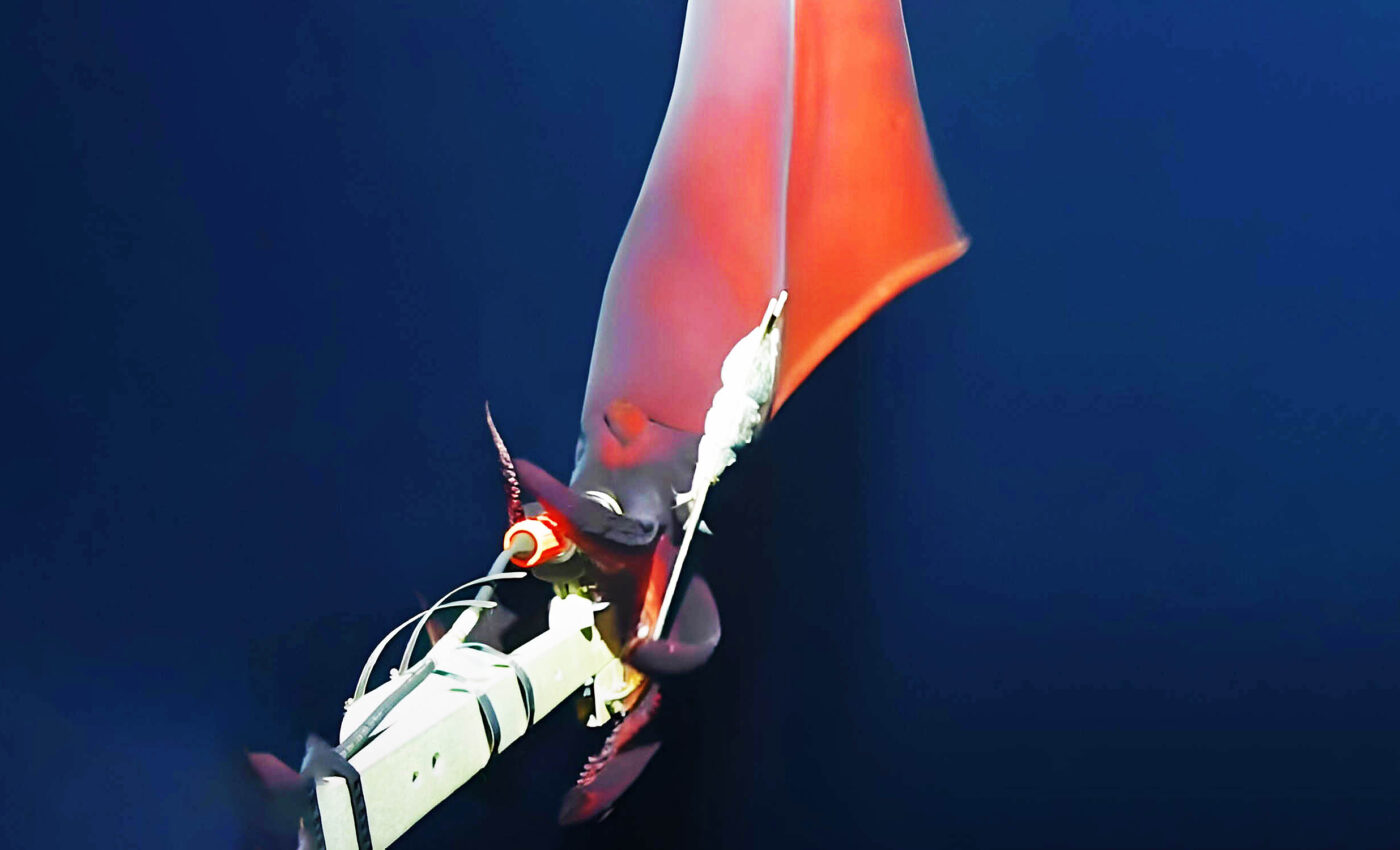
Rare ‘deep-sea hooked squid’ captured on video
Scientists have captured rare footage of a deep-sea hooked squid at a depth of more than a kilometer underwater. The research team made this remarkable observation while deploying free-fall baited cameras north of the Samoan Passage.
Taningia danae: Rare encounter with a deep-sea hooked squid
The deep-sea hooked squid, scientific name Taningia danae, is a fascinating cephalopod that inhabits the deep waters of the world’s oceans.
This species belongs to the family Octopoteuthidae and is one of the largest known deep-sea squid.
Despite its impressive size, which can reach up to 1.7 meters in length, very little is known about its behavior and ecology due to the challenges of observing them in their natural habitat.
Bioluminescent wonder
One of the most striking features of Taningia danae is the presence of two large photophores on the tips of its arms. These photophores are bioluminescent organs that produce bright flashes of light, believed to be used for communication, attracting prey, and startling potential predators.
The photophores of Taningia danae are the largest known in the natural world, making this species a true marvel of deep-sea bioluminescence.
Habitat and distribution
Taningia danae is found in deep waters across the globe, typically at depths ranging from 200 to 2,000 meters. They have been reported in the Atlantic Ocean, Pacific Ocean, and Indian Ocean, indicating a widespread distribution.
However, due to the inaccessibility of their habitat and the rarity of live observations, their precise range and population status remain unclear.
Skillful deep-sea predator
As a predatory species, Taningia danae employs its bioluminescent photophores and powerful arms to hunt a variety of prey in the deep sea.
They are believed to feed on fish, crustaceans, and other cephalopods, using their sharp beak and strong suckers to capture and consume their prey.
The striking bioluminescent displays may also serve to disorient and stun potential prey, giving the squid a crucial advantage in the darkness of the deep sea.
Lights, camera, deep-sea hooked squid
The international research team was led by Associate Professor Heather Stewart from Kelpie Geosciences UK, and an adjunct at The University of Western Australia, along with researchers from the Minderoo-UWA Deep Sea Research Centre.
The scientists held their collective breath as the camera was sinking to the seafloor at a rate of 58 meters per minute. Out of seemingly nowhere, the approximately 3 meter long squid caught up with the lander at a depth of just over 1km.
Associate Professor Stewart recounted the encounter, saying, “The squid descended on our camera assuming it was prey, and tried to startle it with is huge bioluminescent headlights. It then proceeded to wrap its arms around one of other cameras which in turn captured the encounter in even greater detail. I think we were very lucky to have witnessed this.”
Challenges of observing deep-sea squid
Professor Alan Jamieson, director of the Minderoo-UWA Deep Sea Research Centre, emphasized the difficulty in observing deep-sea squid in their natural habitat, particularly in the mid-water.
“Many records of this species are from strandings, accidental bycatch or from the stomach contents of whales,” Jamieson explained.
“The rarity of live observations of these amazing animals makes every encounter valuable in gathering information on geographic locations, depth, and behavior, plus it is such a unique animal that we hardly ever get to see, so we had to share it,” he concluded.
Further research and conservation
The research ship RV Dagon is currently in the final weeks of a three-month expedition, supported by Inkfish, to the Nova Canton Trough located in the Central Pacific Ocean.
The mission aims to explore and document the biodiversity and geodiversity of the seafloor at depths between three and eight kilometers.
This remarkable encounter with the deep-sea hooked squid highlights the importance of continued research and exploration of the ocean’s depths.
Given the scarcity of information on Taningia danae and other deep-sea cephalopods, it is crucial to continue scientific research and exploration efforts to better understand these enigmatic creatures.
As human activities increasingly impact the world’s oceans, it is essential to gather knowledge about deep-sea biodiversity to inform conservation strategies and protect these unique ecosystems.
As scientists continue to delve into the mysteries of the deep sea, we can expect more fascinating discoveries that shed light on the incredible creatures inhabiting these largely unexplored regions of our planet.
Video Credit: University of Western Australia
—–
Like what you read? Subscribe to our newsletter for engaging articles, exclusive content, and the latest updates.
Check us out on EarthSnap, a free app brought to you by Eric Ralls and Earth.com.
—–













